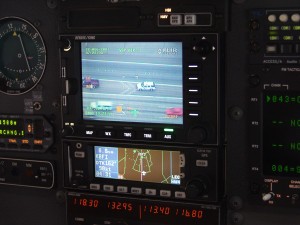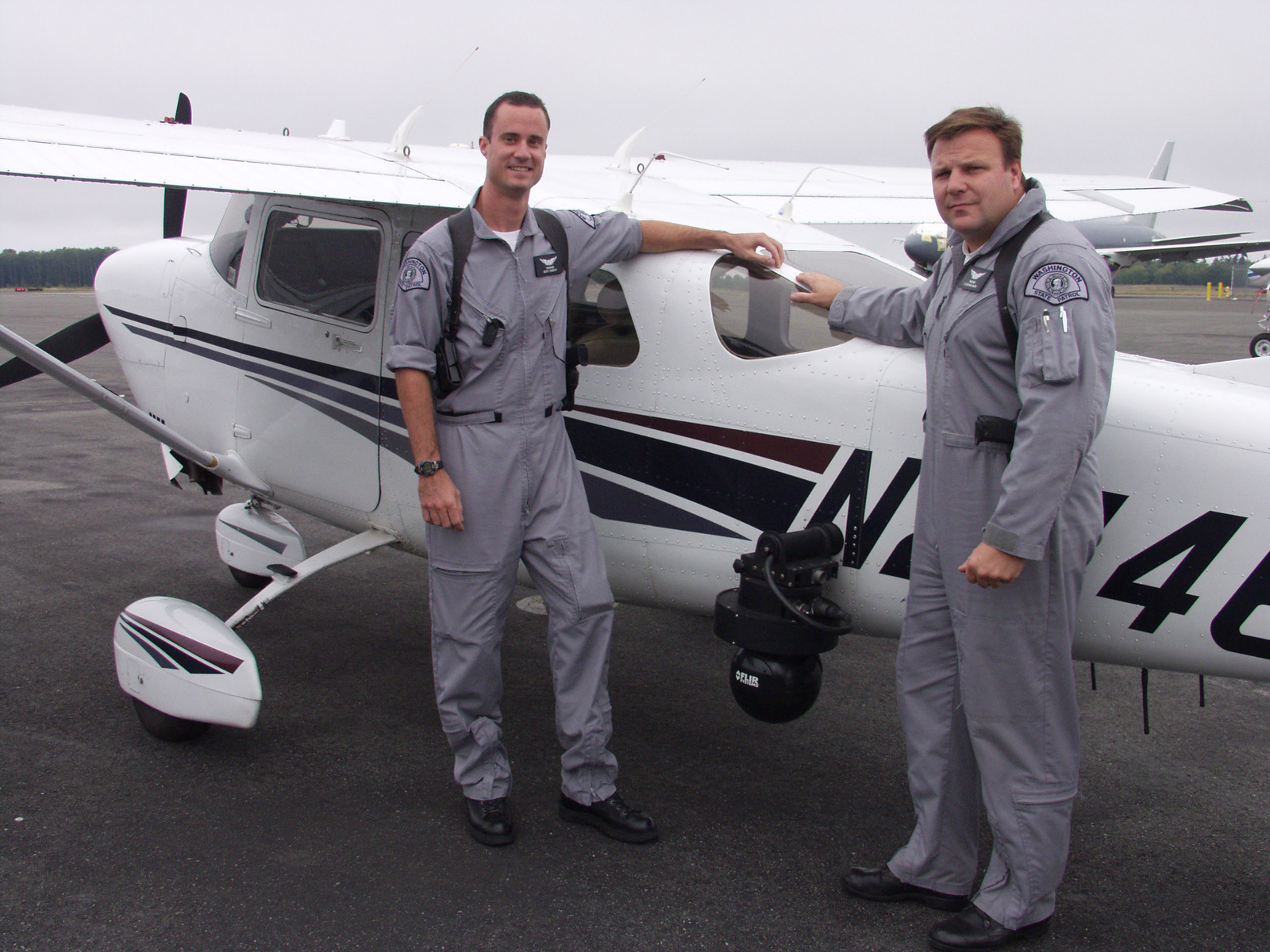
Washington State Patrol troopers Scott Sweeney (left) and “Kort” Korthuis-Smith use this Cessna 206 to patrol Puget Sound freeways. A FLIR camera unit equipped with heat sensors and telephoto lenses is mounted on the side of the plane.
By Terry Stephens
Eyes in the sky often beat feet on the ground. That’s why the Washington State Patrol uses aircraft to stop crime, watch for terrorists and keep roadways clear.
“The majority of states have law enforcement aviation units because they know how much they can do to back up troopers on the ground,” said Capt. Mark Couey.
Couey is in charge of the patrol’s special operations division, which includes the aviation section, based in Washington’s capitol, Olympia.
“We fly a couple of Cessna 206s, three Cessna 182s and two Beechcraft King Airs, with the 206s flying out of Olympia Regional Airport (OLM), mostly for Seattle metro-area coverage. The 182s cover eastern Washington out of Ephrata Municipal Airport (EPH).”
The aviation section will celebrate its 50th anniversary in 2009. It provides traffic enforcement and helps to manage traffic snarls. It also supports troopers and other law enforcement agencies, and collaborates with the patrol’s Homeland Security division, watching for suspicious events possibly linked to terrorism.
On a recent early morning flight over Seattle and Bellevue, troopers Dwayne “Kort” Korthuis-Smith and Scott Sweeney talked about how long days in the cockpit beat any day at a desk and about beautiful clouds and sunrises. They also speculated about the long day ahead. They flight checked their Cessna 206 at 4:30 a.m. in Olympia, and would be patrolling through the rush-hour congestion that afternoon.

Forward-looking infrared cameras are a valuable tool for the Washington State Patrol. Even at night, the heat sensors and telephoto lenses give them an eagle’s view of ground activity.
Even as they chatted, their attention focused on being the eyes in the sky that troopers on the ground count on so often. Sweeney flew racetrack loops up and down Interstate 5 and across the Interstate 90 bridge over Lake Washington, watching for speeders and listening to his flight radios and police channels. He also kept a wary eye on VFR traffic, including television station helicopters and aircraft operating out of Boeing Field (BFI) and Seattle-Tacoma International Airport (SEA).
“We can cover a lot of ground up here and see things troopers on the ground can’t see, such as congested traffic areas,” Sweeney said. “Often we hear a call about congestion problems and a trooper heads for it but the caller gave the wrong location. We can usually spot the congestion and let them know the right location.”
Korthuis-Smith said one of the advantages of the 206 is that it’s big enough to attach a forward looking infrared unit on the fuselage.
A $1 million grant from the Department of Defense allowed the department to purchase two of the expensive FLIR cameras for the west side Cessna 206s. The patrol also coordinates with the federal Department of Homeland Security, checking out suspicious activity near any of the state ferries on Puget Sound or around the Navy’s nuclear submarine base on Hood Canal.
“It’s equipped with gyro-stabilized forward looking infrared cameras, thermal imagers and telephoto lenses,” he said. “All of that is tied into digital recorders and microwave downlink systems. We can send images of what we’re seeing to our Bellevue headquarters, the state’s emergency operations center at Camp Murray, south of Tacoma, and to Homeland Security. Soon, we’ll be able to send camera pictures to the state’s Department of Transportation for distribution to their extensive network of traffic video screens.”

On this early morning flight over Seattle, state patrol troopers see light traffic on Interstate 5, but each day brings speeding, congestion and unexpected events.
Both troopers are pilots, among seven in the aviation section. Many of them are former military aviators. Not all troopers are pilots but all pilots are troopers, Sweeney said. When there’s no tactical officer on board, the copilot operates a rectangular, lap-size control box that includes switches and a joystick that controls the camera operations. What the camera sees is projected onto a laptop computer screen for the operator. The same image can be sent to a smaller screen on the plane’s flight panel, so the pilot can see what’s happening.
Suddenly the troopers’ apparent casualness changes to rapt attention as they track a car moving at 90 miles per hour northbound on I-5. A switch is toggled and the videotape recorder rolls. No troopers on the ground are near the vehicle as it swerves off the interstate and onto a four-lane arterial with slow-moving traffic. The black sports car weaves repeatedly over the double-yellow line to pass other vehicles. The unsuspecting driver finally slows, pulls into a parking lot and stops, apparently at the business where he works. The whole episode is recorded on the FLIR tape, including the large name on the side of the building.
“We track a lot of speeders that way,” Sweeney said. “If we don’t get them the first time, we have a tape to show the judge he’s a regular offender.”

The FLIR screen for the pilot’s view shows a traffic stop on I-5 and a white Washington State Patrol vehicle. The sky troopers regularly circle over freeway incidents to monitor the safety of the trooper on the ground.
Often they’re able to work with ground units to catch speeders. One recent case involved a high-speed motorcycle traveling 140 miles per hour on I-5. Troopers on the ground dropped the chase and backed off as the biker’s speed accelerated. Overhead, their eyes in the sky were watching. A short time later, the speeder pulled into a parking lot, and then looked up. He saw the state patrol plane, but it was too late. The crew had already directed ground units to his hiding place behind a building.
In one recent incident, cameras on the planes helped a state patrol SWAT team raid a home where a man had taken his girlfriend’s son hostage. Another time, an aircrew was able to videotape a drug transaction. The evidence was used to arrest 13 people and seize a cache of methamphetamine.
“You get the most bang for your buck with these aircraft,” Couey said. “They not only cover a lot of ground, but the crew can spot everything from aggressive drivers, stalled vehicles and congestion, to stolen vehicles and emergency situations involving fire trucks or police. We’ve even been able to prove, through a University of Washington study, that we saved businesses more than $1.2 million during 2006 by breaking up a total of 685 miles of congestion with help from our planes.”
Couey said the study calculated the amount of time saved by reducing traffic congestion and translated it into the dollars saved for businesses that didn’t have to pay drivers to sit on gridlocked freeways burning up expensive fuel.











